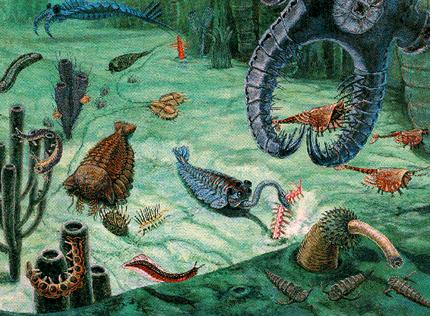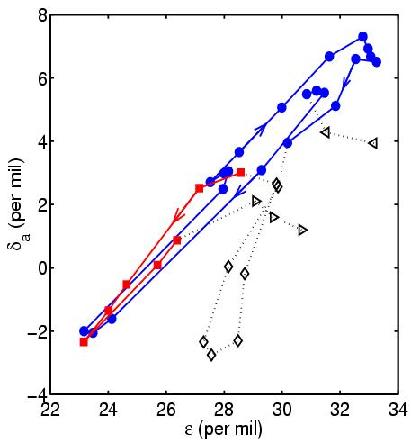
Reconstruction of some of the famous Burgess Shale fossils found in Western Canada, about 530 million years old. They are some of the first evidence of the Cambrian explosion, the rapid radiation of animal life about 20 million years earlier.
The Neoproterozoic Era (ca. 1000-542 Ma) was a time of dramatic environmental and evolutionary change. There were at least three periods of immense glaciation or “Snowball Earth” events between approximately 730 and 580 million years ago with equally dramatic “hot house” aftermaths. There were major changes in seawater chemistry indicated by extreme excursions in the isotopic compositions of elements such as carbon, sulfur and strontium.

The Neoproterozoic attractor: phase-space representation of the Neoproterozoic carbon cycle, indicating that the Earth’s carbon cycle existed in an unusual dynamical state from 800 to 500 million years ago. For more information, see the paper below, Dynamics of the Neoproterozoic Carbon Cycle.
It is also recognized that there were profound environmental changes accompanying the development of complex animal life, both in the Edicaran period (ca. 635-542 Ma) where shallow seas were populated by largely soft bodied and sessile animals known as the Ediacara fauna and in the Cambrian period when motile animals with skeletons made their appearance in large numbers. Environmental changes marking these events are signified by further large isotopic excursions in the carbon isotopic composition of carbonate minerals and organic matter and, for the first time, a clear linkage between the biogeochemical cycles of carbon and sulfur. There is also compound specific carbon isotopic evidence for a change in the oxidation state of the ocean at this time- one of the key factors in the Cambrian explosion.
This project investigates the degree to which the evolution of multicellular life and the biogeochemical cycles are linked. With Dan Rothman’s Group at MIT, we will continue our investigation of the secular variation in isotopic compositions of organic carbon and carbonate carbon from different locations, worldwide where there are known to be well-dated and well preserved sediments. We are also investigating the lipid biomarker contents of these rocks and, through collaborations with other groups, the coeval record of visible and chemical fossils of algae and animals.
Funding sources
NASA Astrobiology Institute, through the Foundations of Complex Life grant
Publications
- Rothman D. H., Hayes J. M., and Summons R. E. (2003) Dynamics of the Neoproterozoic carbon cycle. Proc. Natl. Acad. Sci. (USA) 100: 8124-8129.
Further reading
- Knoll A.H. (2003). Life on a Young Planet: The First Three Billion Years of Evolution on Earth. Princeton University Press. 304 pp.
- Logan G.A., Hayes J.M., Hieshima G.B. and Summons R.E. (1995) Terminal Proterozoic reorganisation of biogeochemical cycles. Nature 376: 53-56.
- Logan G.A., Summons R.E., Hayes J.M. (1997) An isotopic biogeochemical study of Neoproterozoic and Early Cambrian sediments from the Centralian Superbasin. Geochimica et Cosmochimica Acta 61: 5391-5409.


